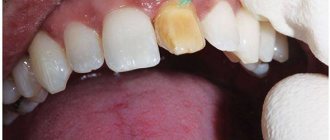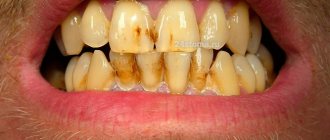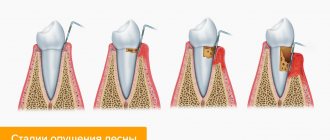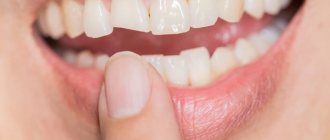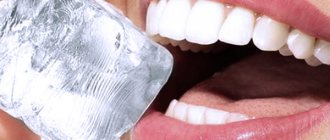Chromogenic components (food, drinks, other products)
The food we eat and other substances we use contain coloring agents (coffee, tea, cola, wine, tobacco, etc.) that can cause yellow, brown or bright orange spots to appear on the skin. teeth In most cases, the discoloration of teeth is generalized, which means that stains tend to form with equal success both on the entire surface of the tooth and in individual areas. If stains appear, it is better to make an appointment with an inexpensive dentist near your place of residence.
Black teeth - why teeth turn black and what to do
Agree, a person with a snow-white smile evokes great sympathy and trust from others. Such people are more socially in demand, successful and satisfied with themselves. Having an open smile is a sign of caring about your health and aesthetic politeness in society. At the same time, a change in the color of the surface of the teeth may indicate an emerging problem. For example, a discovered black plaque requires urgent consultation with a doctor.
Risk factors for developing dark plaque
Healthy teeth are not only a demonstration of heredity, but also an indicator of lifestyle. Black plaque on teeth does not appear overnight, but it has its own reasons:
- irregular dental and oral hygiene;
- errors in nutrition (abuse of sweets, coloring foods, carbonated drinks);
- bad habits (smoking, alcohol, drugs);
- malocclusion, crooked teeth;
- lack of timely treatment;
- lack of microelements in the diet, etc.
It is important to understand the cause of darkening or the appearance of black spots on teeth as early as possible. A person can independently conduct a visual assessment. To do this, you need to carefully examine each tooth and the oral cavity as a whole. If you find a black coating or darkening, you should seek help from a specialist. You should especially hurry if the condition does not improve after several thorough brushings.
A typical cause is a violation of daily hygiene procedures. Remains of drinks and food particles accumulate on the surface of the tooth. They turn into a multilayer plaque that “envelops” the surface of healthy tissue. In the future, this formation serves as fertile ground for the emergence and rapid proliferation of millions of pathogenic bacterial colonies. As a result, the resulting “shell” will darken and cover the healthy, natural color of the tooth. The surface will visually acquire a dull, dark shade.
Prevention and treatment of teeth darkening
A patient menu rich in foods such as natural juices and berries, coffee, herbal and black teas, and red wines can contribute to the formation of darkening and plaque on the teeth. Consumption of finished products containing synthetic dyes (including medications, colored carbonated drinks), flavor enhancers, and sweeteners also have a detrimental effect.
If home care (in the form of brushing twice a day, rinsing after meals, using whitening toothpastes) does not cope with black spots on the teeth, the patient should seek advice and help from a specialist. The list of activities includes professional dental cleaning, as well as:
- ultrasonic teeth cleaning;
- AIR-FLOW-cleaning;
- teeth whitening (if necessary).
The regularity of such procedures is determined individually.
Potential sediment hazards
Another common problem that causes blackening of adult teeth is tartar deposits. Long-term smokers may also suffer from gradual deterioration of enamel and tooth decay. Surfaces that gradually become yellow, covered with tarry tobacco deposits, turn into blackened splintered “stumps”.
It is important to remember that it is possible to cope with problems, which are often localized in the root space or in subgingival pockets, only with the help of comprehensive measures carried out in the clinic. In addition to special cleanings, the patient will be offered a painless and completely safe procedure for removing tartar.
Stages of aesthetic restoration of dental beauty
Dental injuries, caries, excess fluoride (endemic fluorosis), wear and aging of enamel, hereditary diseases - this is not a complete list of reasons that force you to turn to specialists. The treatment program is prescribed individually in each specific case. Therapy includes the following stages:
- Professional care, cleaning of the oral cavity (removal of plaque, tartar, whitening).
- Complex therapeutic measures aimed at restoring the integrity of the dentition and correcting the bite.
- Installation of dentures, veneers, crowns (if necessary).
It is important to remember that “black teeth”, dark spots on the surface of the enamel in children and adults can be prevented by maintaining oral hygiene, limiting the consumption of coloring products and eliminating bad habits from childhood. However, the most important and consistent part of lifelong oral health is regular visits to the dentist's office.
Tooth decay
In the early stages of tooth decay, white spots or spots appear on the tooth enamel. The affected areas lose their natural shine and become dull. A thorough examination reveals the presence of damage to the enamel. If the process of tooth decay progresses, the affected area becomes brown or black, it is necessary to diagnose dental treatment. The damage is initially noticeable as a small dark spot or spots that gradually increase in size (over several months to several years) and often lead to actual tooth decay.
Surgical treatment of gum granuloma
Intervention is necessary in cases where conservative medicine has not had the desired effect. It is required when diagnosing destruction processes in the acute stage. Local or general anesthesia can be used for the operation. The simplest option is gingival excision to expose the purulent sac. The pus flows out, the cavity formed is washed and medicine is placed into it for disinfection and pain relief.
Root resection
During the procedure, the dental surgeon acts as follows:
- The gum tissue is peeled away to gain access to the top of the root system.
- The dental canals are opened and cleaned.
- The formed passages are filled with drugs.
- The granuloma is excised along with the upper part of the tooth.
- The place where the inflamed node used to be is filled with a special bone substitute.
- Filling is being done.
Interradicular hemisection of the root
It is necessary in case of severe damage, when it is no longer possible to cut off only the top while maintaining the main size. Key steps of the operation:
- Removal of the area located inside the alveolus, while the plate itself can be saved.
- Cleaning of periodontal tissues.
- Filling the cavity with a special compound.
- Implant installation.
For preventive purposes, it is necessary to monitor the operated area by regularly taking x-rays. This is an effective and fairly simple method that allows you to preserve a living dental plate, and a neat crown can be installed on the remaining areas in the future.
How to cure granuloma on the root of a tooth with cystotomy
This is a gradual elimination of a large focus of inflammation. To remove all the purulent exudate, an artificial canal is created that connects the inflamed node directly to the oral cavity. After removing the infected fluid, the area is treated with antibiotics and the wound is sutured. The resulting holes can be filled with artificial biomaterial - bone cells. This is a long operation, but it is usually performed without complications.
Removal
It is prescribed as a last resort if other procedures have shown to be ineffective, for example, when:
- Complications arise, an advanced stage.
- An external purulent pocket began to form on the gum.
- A longitudinal crack is formed - the dental plate simply splits into two parts.
- Bone tissue is destroyed (the tooth crumbles).
- Origin of root perforation.
- The canals are destroyed.
During the operation, the root system is completely removed, leaving a hole in the periodontium. It is filled with pus that needs to be washed out. 2-3 months after surgery, a pin can be placed on the healed area to place the implant. Additionally, the doctor prescribes rinsing solutions (for example, Chlorhexidine), gels for local anesthesia and disinfection (Cholisal), as well as antibiotics against bacterial infections and painkillers in tablets or injections.
Therapy
If the filling on the front tooth or on any other tooth has darkened, there are three possible solutions to the problem, the choice of which should be determined by the diagnostic results:
- Removal: performed if the tooth is so damaged that it cannot be cured;
- Removing an old filling, treating caries and installing a new filling material;
- Installation of a dental crown after complete elimination of the pathology.
If complications develop and other diseases occur, additional therapeutic measures may be required to eliminate the source of infection and restore the tooth.
How to treat caries in the form of spots on teeth?
Dental caries goes through several stages. First, a light spot appears on the enamel, which is sometimes even difficult to notice. Then it becomes rough and darkens. If the process is not stopped, the destruction continues further, and a cavity forms in the enamel. At the stage of medium and deep caries, the cavity affects the dentin and gradually expands.
Caries in the form of a dark spot is one of the early stages of carious lesions. Bacteria penetrate into areas of demineralized enamel, producing acid and gas, which stain the enamel dark. At this stage, you can still do without a drill if caries is diagnosed in time.
There are several methods for treating caries in the dark spot stage.
- Remotherapy.
Another name for the method is remineralization. Its essence is to restore the normal mineral composition of the enamel, saturating it with calcium and phosphorus ions. These minerals are delivered to the teeth using pastes, gels, and special compounds that are applied to the surface of the enamel.
- Fluoridation.
Another option for strengthening teeth at the stage of black carious spots is to saturate dental tissues with fluoride. The enamel is coated with gel or fluoride varnish. With simple fluoridation, the drug contains exclusively fluorides, with deep fluoridation - additional minerals, such as calcium.
- ICON method.
This method of treating caries in the form of a black spot has appeared relatively recently. Its essence is that after preliminary treatment and preparation of the tooth, it is coated with a special sealant that seals the enamel pores, preventing bacteria from penetrating deep into the tooth and destroying dentin. The method is safe and painless, suitable for adults and children. But for such treatment it is important to sit for 20 minutes without moving. Therefore, ICON is not prescribed to children under three years of age who find it difficult to sit still for that long.
- Preparation and filling.
Sometimes a carious cavity is hidden behind a small black dot. If during diagnosis the dentist discovers a hole in the tooth, then it will have to be treated surgically using a drill. First, the tooth will be numbed with a modern anesthetic, then areas of dental tissue affected by caries will be removed, the cavity will be treated with antiseptic, medicinal solutions, and an adhesive composition will be applied to the walls for better attachment of the filling material. After this, the prepared cavity is filled with a special composite. Today, light-curing fillings are predominantly used, which harden under the influence of light, last for many years and do not shrink. At the final stage, the dentist will align the tooth according to the bite, grind and polish it.
